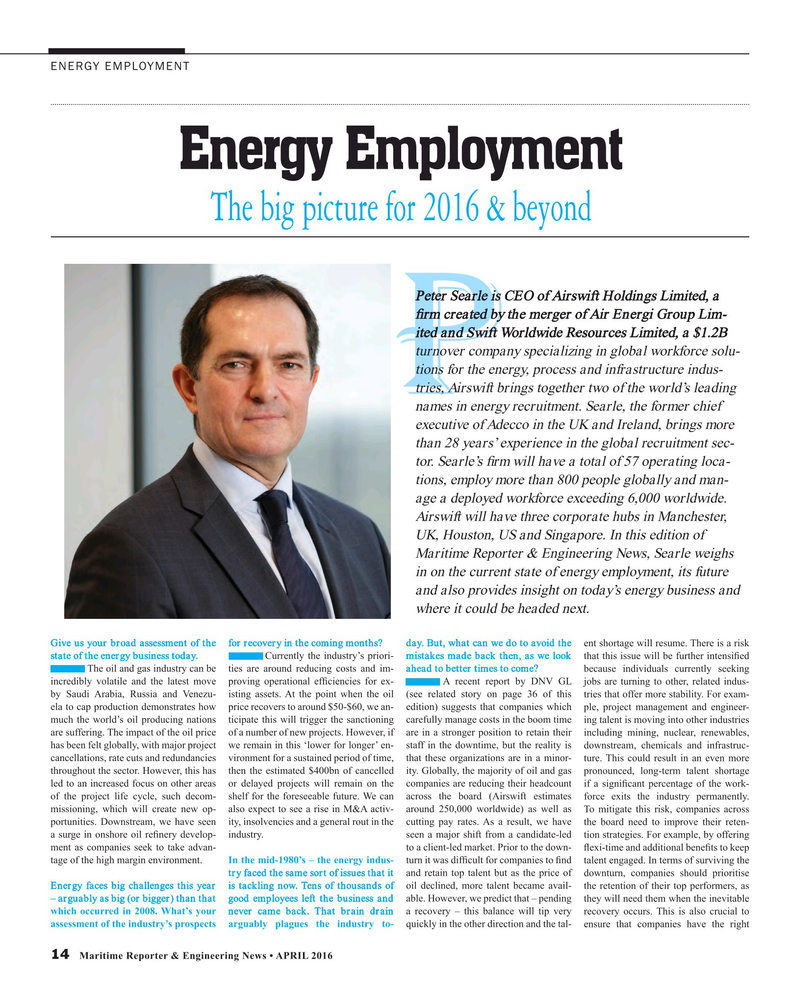
Page 14: of Maritime Reporter Magazine (April 2016)
The Offshore Annual
Read this page in Pdf, Flash or Html5 edition of April 2016 Maritime Reporter Magazine
ENERGY EMPLOYMENT
Energy Employment
The big picture for 2016 & beyond
Peter Searle is CEO of Airswift Holdings Limited, a ? rm created by the merger of Air Energi Group Lim- ited and Swift Worldwide Resources Limited, a $1.2B turnover company specializing in global workforce solu- tions for the energy, process and infrastructure indus- tries, Airswift brings together two of the world’s leading p names in energy recruitment. Searle, the former chief executive of Adecco in the UK and Ireland, brings more than 28 years’ experience in the global recruitment sec- tor. Searle’s ? rm will have a total of 57 operating loca- tions, employ more than 800 people globally and man- age a deployed workforce exceeding 6,000 worldwide.
Airswift will have three corporate hubs in Manchester,
UK, Houston, US and Singapore. In this edition of
Maritime Reporter & Engineering News, Searle weighs in on the current state of energy employment, its future and also provides insight on today’s energy business and where it could be headed next.
Give us your broad assessment of the for recovery in the coming months? day. But, what can we do to avoid the ent shortage will resume. There is a risk state of the energy business today. Currently the industry’s priori- mistakes made back then, as we look that this issue will be further intensi? ed The oil and gas industry can be ties are around reducing costs and im- ahead to better times to come? because individuals currently seeking incredibly volatile and the latest move proving operational ef? ciencies for ex- A recent report by DNV GL jobs are turning to other, related indus- by Saudi Arabia, Russia and Venezu- isting assets. At the point when the oil (see related story on page 36 of this tries that offer more stability. For exam- ela to cap production demonstrates how price recovers to around $50-$60, we an- edition) suggests that companies which ple, project management and engineer- much the world’s oil producing nations ticipate this will trigger the sanctioning carefully manage costs in the boom time ing talent is moving into other industries are suffering. The impact of the oil price of a number of new projects. However, if are in a stronger position to retain their including mining, nuclear, renewables, has been felt globally, with major project we remain in this ‘lower for longer’ en- staff in the downtime, but the reality is downstream, chemicals and infrastruc- cancellations, rate cuts and redundancies vironment for a sustained period of time, that these organizations are in a minor- ture. This could result in an even more throughout the sector. However, this has then the estimated $400bn of cancelled ity. Globally, the majority of oil and gas pronounced, long-term talent shortage led to an increased focus on other areas or delayed projects will remain on the companies are reducing their headcount if a signi? cant percentage of the work- of the project life cycle, such decom- shelf for the foreseeable future. We can across the board (Airswift estimates force exits the industry permanently. missioning, which will create new op- also expect to see a rise in M&A activ- around 250,000 worldwide) as well as To mitigate this risk, companies across portunities. Downstream, we have seen ity, insolvencies and a general rout in the cutting pay rates. As a result, we have the board need to improve their reten- a surge in onshore oil re? nery develop- industry. seen a major shift from a candidate-led tion strategies. For example, by offering ment as companies seek to take advan- to a client-led market. Prior to the down- ? exi-time and additional bene? ts to keep tage of the high margin environment. In the mid-1980’s – the energy indus- turn it was dif? cult for companies to ? nd talent engaged. In terms of surviving the try faced the same sort of issues that it and retain top talent but as the price of downturn, companies should prioritise
Energy faces big challenges this year is tackling now. Tens of thousands of oil declined, more talent became avail- the retention of their top performers, as – arguably as big (or bigger) than that good employees left the business and able. However, we predict that – pending they will need them when the inevitable which occurred in 2008. What’s your never came back. That brain drain a recovery – this balance will tip very recovery occurs. This is also crucial to assessment of the industry’s prospects arguably plagues the industry to- quickly in the other direction and the tal- ensure that companies have the right 14 Maritime Reporter & Engineering News • APRIL 2016
MR #4 (10-17).indd 14 4/6/2016 4:57:12 PM

 13
13

 15
15
